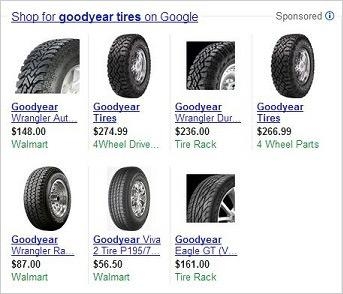Commentary
PLAs Let Businesses Monopolize Search Results
- by Laurie Sullivan , Staff Writer @lauriesullivan, July 15, 2013

The addition of Google
product listing ads has opened a new line item in advertising budgets, as companies continue to increase the amount they spend on these image ads. Advertisers have learned that while Google will not
display more than one search ad in a listing, the company will serve up multiple PLAs from one advertiser per query.
AdGooroo released a report on the top PLA spenders. The company estimates that 4 billion PLAs were displayed on U.S. AdWords from March to May 2013 -- or 5.9% of the total number of AdWords PPC ad impressions, about 71.7 billion PLAs and text ads during that time.
During the three months, eight of the Top 20 advertisers had more PLA impressions served than text ad impressions. Most are small newcomers like Etsy and soap.com, but more traditional retail brands like Staples and Toys R Us also took advantage of images.
The big-box retailers generated the most PLAs -- around 1.22 billion or 17% of the total paid-search ad impressions served by that category. This group also had the majority of multiple ads served simultaneously.
The ability to take over search query results works best for companies with multiple strong brands. Walmart far surpasses all other advertisers when it comes to serving up multiple PLAs in one query during the time AdGooroo collected the data, from March through May 2013 -- sponsoring 408 million impressions from 262,558 unique ads promoting 129,381 different products. A search for Goodyear tires yielded three PLAs from Walmart for tires at different prices, which may help explain why Walmart is so far ahead of the competition in terms of measured impressions.
eBay took the No. 2 position with 187 million impressions across 659,333 unique ads on behalf of 479,855 different products. The Apple Store landed on the Top 20 PLA Advertisers list with 31 million impressions generated from 1,803 different ads featuring only 822 distinct products.
A few lesser-known retailers like bhphotovideo.com appear on the list, although most are top household brands like Target, Best Buy, Overstock, and Macy's. And while Amazon.com spends the most in paid-search advertising -- generating 1.5 billion paid-search text ad impressions during the three-month period -- the AdGooroo report ranks the etailer at No. 75 on the Top PLA Advertisers list, with 9 million impressions.
The category with the highest proportion of impressions in the PLA format was Auctions & Classifieds with 33.8%, according to AdGooroo. The report cites that the Consumer Electronics and Health & Pharmacy categories generated more than 25% of the PLA impressions, while Mass Retailers, Sporting Goods and Children's Goods all came in at around 17%.
PLAs
during that time represent only 0.2% of all ad impressions in the CPG space, and Coupon & Deal Sites about 0.65% -- which seems a little surprising considering the opportunities in these
categories to drive traffic from online to in-store. Similarly, Apparel & Fashion came in at 9.4%; Jewelry, 9.3%; and Shoes, 10.4%.
It will become interesting to see if Google, and
Microsoft Bing, will change the rules on the number of PLAs that serve up simultaneously from one merchant or company. On a mobile device that would surely monopolize search engine results pages.




By serving multiple products at different price points from one retailer, AdWords is essentially enabling/conducting a test of price sensitivity. Very valuable learning would accrue in respect of what economists call price elasticity. And, this learning could attach to the searcher--the consumer's cookie--which AdWords COULD leverage the next time he/she searches. It will be interesting to see if this pattern (of multiple ads by a single retailer) increases or diminishes and appears in other product categories on AdWords in the future.